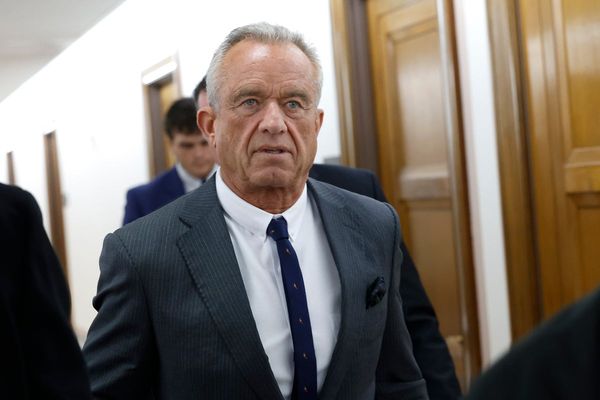
With a great deal of razzle-dazzle, the Chinese Communist Party (CCP) is celebrating its centenary this month. Looking back on a century of party history, Chinese and foreigners alike emphasize themes of success, competence, ideological agility (or adaptability), and ruthlessness—or resolve. A hundred years ago, meeting in a small house in Shanghai in July 1921, a tiny handful of men intrigued by the little bit of Marxism that they knew and impressed by the success of the Russian Revolution agreed that China needed a proletarian revolution. They faced long odds and several near-extinction events, but their heirs rode China’s revolutionary tides to power in 1949.
But a century later, one of the striking accomplishments of the CCP is the degree to which it has fulfilled not Karl Marx’s dreams but those of Sun Yat-sen. Sun, a leader of the Revolution of 1911 who briefly became first president of the Republic of China in 1912, was no communist. But over his long career as a professional revolutionary, he sketched out many plans for how a strong government would develop China’s economy, achieve independence from the imperialist powers, and lead society toward democracy.
For the CCP, Sun Yat-sen is a “Forerunner of the Revolution.” He was one of Mao Zedong’s first political heroes, while in the official historiography of the People’s Republic of China, Sun has long been remembered as a “bourgeois revolutionary” who helped set the stage for the Communist Revolution. In essence, a backward, feudal China at the beginning of the 20th century needed the kind of bourgeois revolution Marx saw in 19th-century Europe. Sun thus played a more or less progressive role in the unfolding of history in China, but a limited one. By the 1940s, Mao had concluded that China’s bourgeois revolution had failed because the bourgeoisie was weak and, worse, in cahoots with the imperialist powers occupying China.
In the early years of the 20th century, Sun envisioned a lively role for markets and entrepreneurs in China’s modernization, while he expected the state to control the economic heights, such as finance, heavy industry, and infrastructure. Reform-era China since the 1980s has, at least roughly speaking, headed in this direction. Sun thought poverty, not class exploitation, lay at the root of China’s problems. Today’s CCP cannot publicly renounce the Marxist-Maoist principle of class struggle, but it has made building a “prosperous society” (xiaokang shehui) a core goal and source of legitimacy.
Sun looked to foreign investment to build China’s infrastructure and export industries—the CCP’s recipe since at least the 1990s. But Sun only wanted foreign companies that agreed to train their Chinese employees and even to sell back their businesses to Chinese owners in the future. Western companies today complain about forced technology transfers, but the idea is hardly a new one. Nor are state-led boycotts of disfavored foreign companies—they began to be a popular political tactic just as Sun began his political career.
A remarkable example of the CCP’s fulfillment of a Sunist dream is today’s immense railway system (90,000 miles, including nearly 24,000 miles of high-speed rail). In 1912 Sun lamented China’s lack of a significant rail system, which he saw could unite geographically diverse regions and form the backbone of economic development. He even sketched out a future system of railway lines crisscrossing China—even while he was trying to find a protected base in a country divided by warlords, Sun found time to think about how train lines could follow rivers and go through or around mountains, and even how they could be paid for.
Another echo of Sunism in today’s China is its policies toward ethnic minorities. Sun achieved his first fame as an anti-Manchu Han Chinese nationalist, condemning the Qing dynasty as illegitimate first and foremost because it represented foreign Manchu control over the majority Ha” population. After the 1911 Revolution that overthrew the Qing, Sun accepted that the Manchus were a Chinese ethnic minority, along with Tibetans, Mongols, Hui, and others. But he never lost his belief that the core Chinese identity was that of the Han people—whether seen as a race, ethnicity, or even lineage. True, he thought the 1911 Revolution had created a new multiethnic nation—but he also believed these different ethnic groups were evolving into a single people that was, indeed, pretty much indistinguishable from its most civilized element: the Han, which would inevitably absorb and assimilate the others.
When it first came to power, the CCP’s approach was almost the opposite of Sun’s. Borrowing from Soviet minorities policy, it officially recognized ethnic groups—55 of them in addition to the Han. It proposed to govern certain minority-dominated frontier areas as autonomous regions and did not initially impose assimilationist policies on them, at least not many. (Fun fact: In the 1930s and into the 1940s, the CCP recognized Taiwan as a separate nation.) However, over the last decade, the CCP has adopted stringent assimilationist policies, from the relatively mundane, like restrictions on minority language schooling, to cultural destruction and mass internment amounting to state terrorism in places such as Tibet and Xinjiang.
It is not that the CCP consciously turned to Sunism but that much of what we associate with the CCP has deeper roots. Part of the CCP’s core identity stemmed from defining itself against Sun’s Nationalist Party (the Kuomintang, abbreviated KMT), though the two parties cooperated to overthrow China’s warlords in the early 1920s. After Sun’s death in 1925 the KMT under Chiang Kai-shek moved to destroy the CCP and build a KMT party-state. Chiang moved to build a cult of Sun Yat-sen, who became known not as a “forerunner” but as the “Father of the Nation.” He remains so in Taiwan today, where the KMT fled after losing the civil war to the Communists in 1949.
Where the CCP in its first 100 years has not followed Sun is in his ideas about democratization. Sun certainly had his doubts about the capacities of the Chinese people to practice democracy in the immediate future. He also had a certain faith in technocratic solutions that is echoed in today’s China. But Sun was always clear that China’s path of development must lead toward constitutional government and democratic institutions. He posited that in the wake of the revolution, a brief period of military government would be necessary to restore order and eliminate corruption. Then a period of “tutelage” would begin. Sun seems to have thought of tutelage in terms of limited local self-government under the final command of central authorities, which would teach the public their civic responsibilities and eventually produce an educated, modern populace capable of governing itself.
In many ways, the CCP has been engaged in tutelage projects since at least the 1940s. Its “rectification” campaigns centered on small groups of cadres, or merchants, or academics engaged in intense study of party documents, mutual criticism, and self-criticism for months at a time. The “new person” was to emerge utterly devoted to one ideal: “to serve the people.” Today, less ambitiously but still hopefully the government issues endless calls for “civilized behavior.” And of course the CCP’s punishments for unacceptable political views and behavior are nothing if not disciplinary. It seems to be tutelage all the way down—albeit with little sight of a democratic end goal.
In the period of “opening and reform” starting in the 1980s, China began experiments with local multicandidate elections (not multiparty elections), relaxing censorship (within limits), and promoting a new judicial system (subject to party discipline). Over the last 15 years, however, even these limited reforms have been curtailed. Recent CCP communiques explicitly condemn such notions as universal values, constitutionalism, human rights, civil society, and “historical nihilism” (that is, criticizing the party). And now, named for China’s current president, “Xi Jinping Thought on Socialism with Chinese Characteristics for a New Era” is omnipresent, found across sites ranging from schoolrooms and street posters to computer games—the ultimate tutelage project.
In the 1930s, the KMT tried to legitimate its rule with the concept of “tutelage,” while Chiang believed much more in duties than in rights. But in Taiwan, though Chiang ruled through martial law, society slowly liberalized. It is possible to look at the democratization of Taiwan since the 1980s, achieved without wide-scale violence, and forget the years of the Taiwanese people’s struggle against oppression. Opposition to KMT authoritarianism focused on ideals of open elections, Taiwanization, and, to an extent, labor rights. In the wake of demonstrations held on Human Rights Day in 1979, police arrested dozens of opposition leaders in what became known as the Kaohsiung Incident. But in the long run, this strengthened the opposition just as the KMT—threated by the decision that year of the United States to finally formally recognize the Beijing government instead of Taipei—began step-by-step reforms. Another key moment came with the Wild Lily student movement of 1990 demanding new popular elections for the National Assembly and direct election of the president. This time, the protesters were not prosecuted.
The story of Taiwan’s democratization is a complex one, but Sunism played a role. In the pivotal year of 1990, some KMT and military elites opposed meeting the students’ demands and wanted the government to take a hard line. This so-called palace faction might have gotten its way but for the argument that Sun Yat-sen himself had said that the purpose of tutelage was democracy. Even if Sunism had lost most of its appeal in the larger Taiwanese society, these conservatives could not bring themselves to oppose the Sunism that they still believed in. Taiwan’s largely peaceful democratic revolution was completed over the course of the 1990s. Today, as the CCP celebrates its 100th anniversary, the world’s most successful communist party should be seen in the context of a longer and larger revolutionary tradition that is still ongoing.







